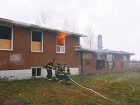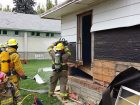
Back to Basics: Start with a simple size-up
Mark Van
Features Structural TrainingIn the January issue, we examined the first three points of the basics or foundations of fire fighting that every firefighter should know: your equipment; your crew; and your response area. The last two basics are size-up and training.
Before we dive in, we need to clarify a small matter: a photo with the January column showed a firefighter wearing his face piece incorrectly – the face piece was put on over the flash hood. This photo was taken at a training event and was used on purpose, to reinforce the importance of knowing your equipment. Instructors immediately spoke with the firefighter and the situation was corrected.
Size-up
Firefighters need to have a basic understanding of size-up and understand how it applies to themselves as well as other aspects of the fire ground.
All firefighters need to be aware of their own limitations and those of other firefighters. Even though we may think we are invincible and capable of doing everything, we are not – you are not! We all have limitations and knowing what they are helps prevent firefighters from being caught in situation that may require self-rescue. Knowing what other firefighters can do is also a benefit: if you are or paired up with another firefighter for a task assignment, it is good to know if your colleague is going to be a benefit to the team or a hindrance.
Size-up also includes the structure and the fire ground. As we have been taught in basic training, size-up begins when the call is dispatched and it ends when all crews are back at the station. This continuous process is required because the fire ground is dynamic with changes happening, often for the better but sometimes for the worse.
For structural size-up, it’s important to determine entry and exit points so that firefighters can get out and get out quickly. We never want to enter a structure without knowing exits other than the initial entry point. This process includes identifying door and window locations, noting the types and size, and recognizing any obstructions or barriers. If windows are obstructed by security bars, the rapid intervention team (RIT) must remove the bars while there are teams inside.
Firefighters must also size-up the number of storeys; this is especially important for situational awareness. Some structures may look to be two storeys from the front, but may actually be three or more storeys. When a firefighter reports to command on a mayday call, it is critical to know the location so the RIT team can respond quickly.
Lastly, firefighters want to size up the location of the fire; this is important for the team making entry as well as for individual firefighters. The location of the fire dictates the actions to be taken to combat it. Knowing the location of the fire also keeps firefighters aware of their actions in relation to the fire and helps to prevent anyone being caught between the fire and the exit. Situational awareness of surroundings includes knowing where the fire is and what it is doing.
Training
Training is the cornerstone of firefighter survival and it paves the way for firefighters to be able to self-rescue from a dire situation. For training to be effective, it needs to be both constant and consistent.
Constant training means training every day or every shift or every training night. Constant training allows firefighters to exercise muscle memory to develop skill sets. The goal of training is to refine skills and make firefighters better at what they do.
To perfect those skills, training also needs to be consistent. Firefighters develop habits; good habits develop from consistent training. Training is not isolated to an official training time, but occurs every time we don our gear and respond to a call. This is why we need to be consistent – developing good habits rather than bad habits; the good habits will save us when face a life-or-death situation.
Mark van der Feyst has been in the fire service since 1999 and is a full-time firefighter in Ontario. He teaches in Canada, the United States and India and is lead author of Residential Fire Rescue. Mark@FireStarTraining.com
Print this page
Advertisement
- Extrication Tips: Things to consider at the scene of a collision
- Fit for Duty: HIIT hard and get fit faster

